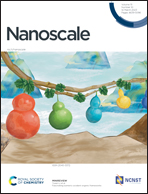Novel aggregation-induced emission-photosensitizers with built-in capability of mitochondria targeting and glutathione depletion for efficient photodynamic therapy†
Abstract
Owing to its non-invasive feature and excellent therapeutic effect, photodynamic therapy has received considerable interest in cancer therapy. However, the therapeutic efficacy of photodynamic therapy is limited by some intrinsic drawbacks of photosensitizers such as aggregation-caused quenching and non-specificity towards cellular organelles. Moreover, the overexpressed glutathione in tumour cells which exhibits a potent scavenging effect on reactive oxygen species generated during the photodynamic therapy process also reduces the efficacy of photodynamic therapy. Therefore, the synthesis of aggregation-induced emission based photosensitizers with cellular organelle targeting and glutathione-depletion capability is highly desirable in photodynamic therapy. Here, two new aggregation-induced emission based photosensitizers namely tetraphenylethylene-1-phenyvinyl-pyridine-phenylboronic acid (TPEPy-BA) and tetraphenylethylene-1-phenyvinyl-pyridine-phenylboronic acid pinacol ester (TPEPy-BE) were synthesized which easily aggregated under aqueous conditions and showed bright emission in the near infra-red region. Furthermore, these photosensitizers were encapsulated into an amphiphilic block copolymer (DSPE-PEG) to improve the aqueous stability and cellular internalization of photosensitizers. The developed photosensitizer nanoparticles showed high reactive oxygen species generation efficacy, mitochondria-targeting and glutathione-depletion capability. The results showed that tetraphenylethylene-1-phenyvinyl-pyridine-phenylboronic acid pinacol ester nanoparticles exhibited a highly efficient photodynamic ablation of MCF-7 cells compared to tetraphenylethylene-1-phenyvinyl-pyridine-phenylboronic acid nanoparticles, upon white light irradiation, due to its high intracellular reactive oxygen species generation efficiency and mitochondria-dysfunction ability. Moreover, tetraphenylethylene-1-phenyvinyl-pyridine-phenylboronic acid pinacol ester nanoparticles produced a glutathione-depleting adjuvant, quinone methide, which greatly reduced the glutathione level in cancer cells, thus enhancing the efficacy of photodynamic therapy. This study provides a new strategy for the synthesis of aggregation-induced emission based photosensitizers with combined mitochondria-targeting and glutathione-depletion capability for efficacious photodynamic therapy.



 Please wait while we load your content...
Please wait while we load your content...